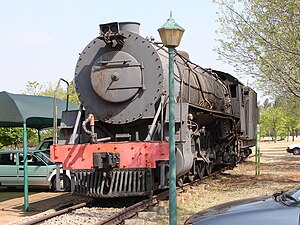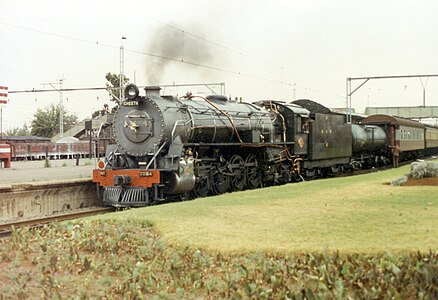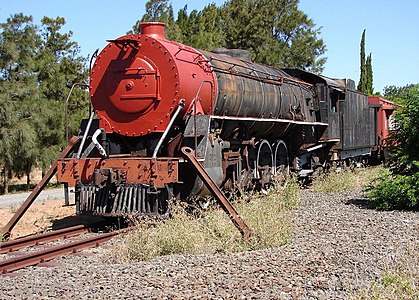South African Class 15CA 4-8-2
| South African Class 15CA 4-8-2 | |||||||||||||||||||||||||||||||||||||||||||||||||||||||||||||||||||||||||||||||||||||||||||||||||||||||||||||||||||||||||||
|---|---|---|---|---|---|---|---|---|---|---|---|---|---|---|---|---|---|---|---|---|---|---|---|---|---|---|---|---|---|---|---|---|---|---|---|---|---|---|---|---|---|---|---|---|---|---|---|---|---|---|---|---|---|---|---|---|---|---|---|---|---|---|---|---|---|---|---|---|---|---|---|---|---|---|---|---|---|---|---|---|---|---|---|---|---|---|---|---|---|---|---|---|---|---|---|---|---|---|---|---|---|---|---|---|---|---|---|---|---|---|---|---|---|---|---|---|---|---|---|---|---|---|---|
 No. 2802 at Esselen Park, 21 September 2009 | |||||||||||||||||||||||||||||||||||||||||||||||||||||||||||||||||||||||||||||||||||||||||||||||||||||||||||||||||||||||||||
| |||||||||||||||||||||||||||||||||||||||||||||||||||||||||||||||||||||||||||||||||||||||||||||||||||||||||||||||||||||||||||
| |||||||||||||||||||||||||||||||||||||||||||||||||||||||||||||||||||||||||||||||||||||||||||||||||||||||||||||||||||||||||||
| |||||||||||||||||||||||||||||||||||||||||||||||||||||||||||||||||||||||||||||||||||||||||||||||||||||||||||||||||||||||||||
| |||||||||||||||||||||||||||||||||||||||||||||||||||||||||||||||||||||||||||||||||||||||||||||||||||||||||||||||||||||||||||
| ♠ The leading coupled axle had flangeless wheels | |||||||||||||||||||||||||||||||||||||||||||||||||||||||||||||||||||||||||||||||||||||||||||||||||||||||||||||||||||||||||||
The South African Railways Class 15CA 4-8-2 of 1926 was a steam locomotive.
In 1926, the South African Railways placed 23 Class 15CA steam locomotives with a 4-8-2 Mountain type wheel arrangement in service. Another 61 engines were ordered and delivered from three manufacturers in 1929 and 1930.[1][2][3]
Class 15C redesign
[edit]
After the twelve Class 15C Big Bill 4-8-2 Mountain type locomotives which were delivered by Baldwin Locomotive Works in 1925 had been in service a short while, it was discovered that the frames under the front of the firebox had a tendency to crack, necessitating heavy repairs.[1][2]
To overcome this, a new modified design was prepared by Col F.R. Collins DSO, the Chief Mechanical Engineer (CME) of the South African Railways (SAR), for an almost identical locomotive but with the frames shortened to the front of the firebox and widened under the firebox by means of a bridle casting.[1]
Manufacturers
[edit]The first batch of 23 of these redesigned locomotives were built for the SAR by the American Locomotive Company (ALCO). They were delivered in 1926, numbered in the range from 2039 to 2059, 2072 and 2073, and designated Class 15CA. The "A" supposedly indicated the manufacturer ALCO rather than, as was usual SAR practice, a different version of an existing locomotive type.[1][2][3][4]
The earlier Baldwin-built Class 15C was then reclassified to Class 15CB for no good reason, since the "B" merely indicated the manufacturer Baldwin and not, as was usual practice, a branchline locomotive.[4]
Another 61 Class 15CA locomotives were acquired in four batches from three other manufacturers in 1929 and 1930. Like the 23 ALCO-built locomotives, all except the last batch were built with 23 inches (584 millimetres) bore cylinders.[2]
- In 1929, four engines were delivered by Baldwin Locomotive Works in the United States of America, numbered in the range from 2074 to 2077.[2]
- Also in 1929, ten locomotives were delivered by Società Italiana Ernesto Breda of Milan in Italy (now AnsaldoBreda), numbered in the range from 2801 to 2810.[2][4]
- Also in 1929, 29 engines were built by the North British Locomotive Company (NBL) and delivered in that same year, numbered in the range from 2811 to 2839.[2][5]
- The last 18 Class 15CA locomotives were also built by NBL in 1929. These were delivered in 1930 and numbered in the range from 2840 to 2857. This last batch of engines were built with larger 24 inches (610 millimetres) bore cylinders and larger diameter trailing wheels.[2][5]
Characteristics
[edit]Apart from the redesigned frame under the firebox, these locomotives were very similar to the Class 15C in proportions and appearance. They also had Coale pop type safety valves, a Schmidt type superheater and a combustion chamber in the firebox, which was equipped with flexible side stays and water siphon arch tubes. Their coupled wheel axleboxes, crank pins and connecting rod big ends were grease lubricated. These engines used the same Type KT tenders with a coal capacity of 14 long tons (14.2 tonnes) and a water capacity of 6,000 imperial gallons (27,300 litres).[2][1]
Modifications
[edit]Retyring
[edit]The locomotives were delivered with 57 inches (1,448 millimetres) diameter coupled wheels and their boilers were set at an operating pressure of 200 pounds per square inch (1,379 kilopascals). All their coupled wheels were eventually retyred to a 60 inches (1,524 millimetres) diameter and to compensate for the loss of tractive effort due to the larger diameter wheels, their operating boiler pressure was increased from 200 to 210 pounds per square inch (1,379 to 1,448 kilopascals) by an adjustment of the setting of their safety valves. This modification enabled these mixed traffic locomotives to handle the fastest mainline passenger trains.[1][6][7]
In addition, all those locomotives which had been built with 23 inches (584 millimetres) bore cylinders had their cylinders reamed to a bore of 24 inches (610 millimetres).[2]
When larger tyres were fitted to their coupled wheels, the old tyres were left in position and turned down on the wheel centres to serve as liners and the new tyres were then shrunk on over the liners. The leading coupled wheels, which had been flangeless as built, were flanged during the retyring. The practice of increasing the diameter of coupled wheels, wheel spacing and other considerations permitting, was begun by A.G. Watson during his term in office as CME and was continued by his successors. The reduction of tractive effort caused by the larger wheels was made up by increasing boiler pressure or by fitting larger cylinders or both, as required. This policy resulted in more mileage between heavy repairs, less cost-per-mile on repairs and locomotives capable of higher speeds.[2]
Reboilering
[edit]During the early 1940s, three of the Class 15CB and Class 15CA locomotives were reboilered with new boilers numbered in the range from 9504 to 9506. These boilers were of similar dimensions as the originals but with a different tube arrangement. It was designed by Dr. M.M. Loubser, CME at the time. The reboilered locomotives were not reclassified.[6][7]
Service
[edit]South African Railways
[edit]
The Class 15CA locomotives were placed in service on the mainline between Cape Town and Kimberley but like the Class 15CB, they were later transferred to Bloemfontein. From here they worked throughout the Free State until they were eventually relocated to the Eastern Transvaal system. There they worked out of Pretoria to Pietersburg in the north and from there to Tzaneen in the east and Messina on the Rhodesian border in the north. Some also worked out of Witbank and Breyten.[3][4]
In the early 1960s, a few joined the Class 15CB on the National North Coast line. Here they were used on, amongst others, the night and day passenger trains to and from Empangeni on the north coast line and on passenger trains to and from Kelso on the south coast line. In 1983, they all went from there to the Cape Northern system for use on the lines from Beaconsfield in Kimberley, working north to Mafeking and south to De Aar. Eventually nearly forty of them ended up as heavy shunters at Kaserne and Germiston in Johannesburg where they replaced the Class 12AR and Class S1.[3][4][8][9]
15CA 2828 is now plinthed at the Gospel Express, Vinkrivier Station, R60, Robertson, is the Western Cape, South Africa. 2828 completes the 11 coaches stationed at Vink, as accommodation for the Gospel Express Christian Centre.
Industry
[edit]Three Class 15CA locomotives were sold into industrial service. Numbers 2807 and 2839 went to Dunn's Locomotive Works and were eventually sold to Rustenburg Platinum Mines. No. 2811 went to South Witbank Colliery as their no. 4.[4][10]
Works numbers
[edit]The table lists the Class 15CA engine numbers, builders, years built and the builders' works numbers. The colour coding following the engine numbers refers to the three axle loadings of the different batches of the Class 15CA, as shown in the table of specifications.
SAR No. |
Builder |
Year |
Works No. |
|---|---|---|---|
| 2039 ʘ | ALCO | 1926 | 66986 |
| 2040 ʘ | ALCO | 1926 | 66987 |
| 2041 ʘ | ALCO | 1926 | 66988 |
| 2042 ʘ | ALCO | 1926 | 66989 |
| 2043 ʘ | ALCO | 1926 | 66990 |
| 2044 ʘ | ALCO | 1926 | 66991 |
| 2045 ʘ | ALCO | 1926 | 66992 |
| 2046 ʘ | ALCO | 1926 | 66993 |
| 2047 ʘ | ALCO | 1926 | 66994 |
| 2048 ʘ | ALCO | 1926 | 66995 |
| 2049 ʘ | ALCO | 1926 | 66996 |
| 2050 ʘ | ALCO | 1926 | 66997 |
| 2051 ʘ | ALCO | 1926 | 66998 |
| 2052 ʘ | ALCO | 1926 | 66999 |
| 2053 ʘ | ALCO | 1926 | 67000 |
| 2054 ʘ | ALCO | 1926 | 67001 |
| 2055 ʘ | ALCO | 1926 | 67002 |
| 2056 ʘ | ALCO | 1926 | 67003 |
| 2057 ʘ | ALCO | 1926 | 67004 |
| 2058 ʘ | ALCO | 1926 | 67005 |
| 2059 ʘ | ALCO | 1926 | 67006 |
| 2072 ʘ | ALCO | 1926 | 67007 |
| 2073 ʘ | ALCO | 1926 | 67008 |
| 2074 ʘ | Baldwin | 1929 | 60828 |
| 2075 ʘ | Baldwin | 1929 | 60829 |
| 2076 ʘ | Baldwin | 1929 | 60830 |
| 2077 ʘ | Baldwin | 1929 | 60831 |
| 2801 ʘ | Breda | 1929 | 2236 |
| 2802 ʘ | Breda | 1929 | 2237 |
| 2803 ʘ | Breda | 1929 | 2238 |
| 2804 ʘ | Breda | 1929 | 2239 |
| 2805 ʘ | Breda | 1929 | 2240 |
| 2806 ʘ | Breda | 1929 | 2241 |
| 2807 ʘ | Breda | 1929 | 2242 |
| 2808 ʘ | Breda | 1929 | 2243 |
| 2809 ʘ | Breda | 1929 | 2244 |
| 2810 ʘ | Breda | 1929 | 2245 |
| 2811 ʘ | NBL | 1928 | 23774 |
| 2812 ʘ | NBL | 1928 | 23775 |
| 2813 ʘ | NBL | 1928 | 23776 |
| 2814 ʘ | NBL | 1928 | 23777 |
| 2815 ʘ | NBL | 1928 | 23778 |
| 2816 ʘ | NBL | 1928 | 23779 |
| 2817 ʘ | NBL | 1928 | 23780 |
| 2818 ʘ | NBL | 1928 | 23781 |
| 2819 ʘ | NBL | 1928 | 23782 |
| 2820 ʘ | NBL | 1928 | 23783 |
| 2821 ʘ | NBL | 1928 | 23784 |
| 2822 ʘ | NBL | 1928 | 23785 |
| 2823 ʘ | NBL | 1928 | 23786 |
| 2824 ʘ | NBL | 1928 | 23787 |
| 2825 ʘ | NBL | 1928 | 23788 |
| 2826 ʘ | NBL | 1928 | 23789 |
| 2827 ʘ | NBL | 1928 | 23790 |
| 2828 ʘ | NBL | 1928 | 23791 |
| 2829 ʘ | NBL | 1928 | 23792 |
| 2830 ʘ | NBL | 1928 | 23793 |
| 2831 ʘ | NBL | 1928 | 23794 |
| 2832 ʘ | NBL | 1928 | 23795 |
| 2833 ʘ | NBL | 1928 | 23796 |
| 2834 ʘ | NBL | 1928 | 23797 |
| 2835 ʘ | NBL | 1928 | 23798 |
| 2836 ʘ | NBL | 1928 | 23799 |
| 2837 ʘ | NBL | 1928 | 23800 |
| 2838 ʘ | NBL | 1928 | 23801 |
| 2839 ʘ | NBL | 1928 | 23802 |
| 2840 ʘ | NBL | 1929 | 24008 |
| 2841 ʘ | NBL | 1929 | 24009 |
| 2842 ʘ | NBL | 1929 | 24010 |
| 2843 ʘ | NBL | 1929 | 24011 |
| 2844 ʘ | NBL | 1929 | 24012 |
| 2845 ʘ | NBL | 1929 | 24013 |
| 2846 ʘ | NBL | 1929 | 24014 |
| 2847 ʘ | NBL | 1929 | 24015 |
| 2848 ʘ | NBL | 1929 | 24016 |
| 2849 ʘ | NBL | 1929 | 24017 |
| 2850 ʘ | NBL | 1929 | 24018 |
| 2851 ʘ | NBL | 1929 | 24019 |
| 2852 ʘ | NBL | 1929 | 24020 |
| 2853 ʘ | NBL | 1929 | 24021 |
| 2854 ʘ | NBL | 1929 | 24022 |
| 2855 ʘ | NBL | 1929 | 24023 |
| 2856 ʘ | NBL | 1929 | 24024 |
| 2857 ʘ | NBL | 1929 | 24025 |
Preservation
[edit]| Number | Works nmr | THF / Private | Leaselend / Owner | Current Location | Outside South Africa | ? |
|---|---|---|---|---|---|---|
| 2039 | ALCO 66986 | THF/Private | MISLPT (Michael Barclay) | Krugersdorp Locomotive Depot | Ownership Unclear | |
| 2040 | ALCO 66987 | THF/Private | MISLPT (Michael Barclay) | Krugersdorp Locomotive Depot | Ownership Unclear | |
| 2041 | ALCO 66988 | THF/Private | MISLPT (Michael Barclay) | Krugersdorp Locomotive Depot | Ownership Unclear | |
| 2055 | ALCO 67005 | THF | Rustenburg (Station) | |||
| 2056 | ALCO 67003 | THF | Reefsteamers | Germiston Locomotive Depot | ||
| 2077 | BAL 60831 | THF/Private | MISLPT (Michael Barclay) | Krugersdorp Locomotive Depot | Ownership Unclear | |
| 2802 | BREDA 2237 | THF | Esslenpark Railway College | |||
| 2803 | BREDA 2238 | THF/Private | MISLPT (Michael Barclay) | Krugersdorp Locomotive Depot | Ownership Unclear | |
| 2804 | BREDA 2239 | THF | Esslenpark Railway College | |||
| 2820 | NBL 23783 | THF/Private | MISLPT (Michael Barclay) | Krugersdorp Locomotive Depot | Ownership Unclear | |
| 2825 | NBL 23788 | THF | Krugersdorp Locomotive Depot | |||
| 2828 | NBL 23791 | THF | Gospel Express | Vink (Station) | ||
| 2833 | NBL 23796 | THF | Krugersdorp Locomotive Depot | |||
| 2836 | NBL 23799 | THF | Krugersdorp Locomotive Depot | |||
| 2850 | NBL 24018 | THF | Wonder Steam Trains | Hermanstad Depot | ||
| 2853 | NBL 24021 | THF | Krugersdorp Locomotive Depot |
Illustration
[edit]The main picture shows Breda-built no. 2802, serving as school guard at Esselen Park, the Transnet School of Rail in Kaalfontein, Gauteng, on 21 September 2009.
-
NBL-built no. 2850 at Kroonstad, Orange Free State, 22 April 1979
-
ALCO-built no. 2054 Cheeta at Vereeniging, 7 October 1989
-
NBL-built no. 2828, staged at Vink siding near Robertson, 11 January 2008.
-
NBL-built no. 2828, now in royal blue and with number plates, 20 October 2009.
References
[edit]- ^ a b c d e f Holland, D. F. (1972). Steam Locomotives of the South African Railways. Vol. 2: 1910-1955 (1st ed.). Newton Abbott, England: David & Charles. pp. 46, 49–50. ISBN 978-0-7153-5427-8.
- ^ a b c d e f g h i j k Espitalier, T.J.; Day, W.A.J. (1946). The Locomotive in South Africa - A Brief History of Railway Development. Chapter VII - South African Railways (Continued). South African Railways and Harbours Magazine, May 1946. pp. 375-376.
- ^ a b c d Paxton, Leith; Bourne, David (1985). Locomotives of the South African Railways (1st ed.). Cape Town: Struik. pp. 10–11, 61–62. ISBN 0869772112.
- ^ a b c d e f Durrant, AE (1989). Twilight of South African Steam (1st ed.). Newton Abbott: David & Charles. pp. 86–87. ISBN 0715386387.
- ^ a b North British Locomotive Company works list, compiled by Austrian locomotive historian Bernhard Schmeiser
- ^ a b South African Railways & Harbours/Suid Afrikaanse Spoorweë en Hawens (15 Aug 1941). Locomotive Diagram Book/Lokomotiefdiagramboek, 3'6" Gauge/Spoorwydte. SAR/SAS Mechanical Department/Werktuigkundige Dept. Drawing Office/Tekenkantoor, Pretoria. pp. 19-20, 45-46.
- ^ a b South African Railways & Harbours/Suid Afrikaanse Spoorweë en Hawens (15 Aug 1941). Locomotive Diagram Book/Lokomotiefdiagramboek, 2'0" & 3'6" Gauge/Spoorwydte, Steam Locomotives/Stoomlokomotiewe. SAR/SAS Mechanical Department/Werktuigkundige Dept. Drawing Office/Tekenkantoor, Pretoria. pp. 6a-7a, 19-20, 45-46.
- ^ Soul of A Railway, System 6, Part 1: Durban Old Station. Caption 78. Archived 24 October 2020 at the Wayback Machine (Accessed on 8 March 2017)
- ^ Soul of A Railway, System 6, Part 2: Greyville Loco, Greyville Station to Umgeni & Berea Road to Rossburgh. Caption 36. Archived 2 February 2017 at the Wayback Machine (Accessed on 26 November 2016)
- ^ Middleton, John N. (2002). Railways of Southern Africa Locomotive Guide - 2002 (as amended by Combined Amendment List 4, January 2009) (2nd, Dec 2002 ed.). Herts, England: Beyer-Garratt Publications. p. 22.
External links
[edit]| External videos | |
|---|---|




